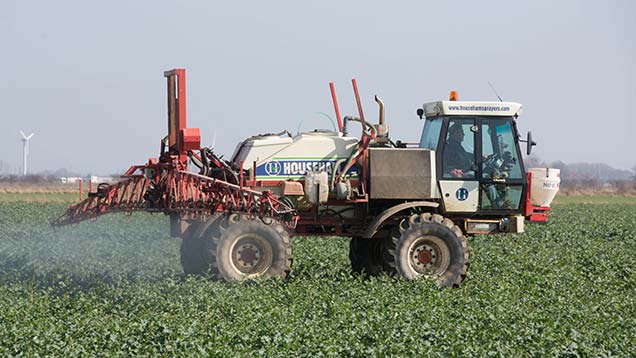Spray timings key to beat turnip yellows virus in OSR

Turnip yellows virus (TuYV) reached epidemic levels in some parts of the UK this summer and the neonitotinoid seed treatment ban means growers need to get the most out of their autumn insecticides.
Parts of England has seen TuYV infection soar as high as 92%, with the south of England, Somerset and Yorkshire hardest hit.
The levels were described as “worrying” by John Walsh of Warwick University, as he highlighted that levels of infection are much higher than they have been for the past few seasons.
See also: Turnip yellows virus hotspots revealed in nationwide oilseed rape survey
Request to authorise Teppeki use
Belchim has applied for a 120-day Emergency Authorisation for this coming autumn for the use of Teppeki (flonicamid) to control Myzus persicae (peach-potato aphid) on oilseed rape.
UK marketing and development manager Simon Leak says it would offer farmers a third active, as last season.
“It is a feeding inhibitor that stops aphids feeding within one hour of application. A decision is expected in early September,” he says.
“We are also carrying out trials on timing, to find the optimum time to treat crops. Last year many were applied in October, but this was perhaps too late and September may offer better control.
“Trials are also being undertaken to measure the effect on yield.”
He believes the level of aphid activity in a season broadly correlates with the level of virus infection in oilseed rape crops.
“Last winter was mild and there were high levels of peach-potato aphid, leading to very high levels of the virus,” he explains.
With the virus costing the industry £100m each year, with up to 30% loss in yield, what can farmers do to tackle the threat this coming autumn?
TuYV is carried and transmitted by about 20 aphid species, but the most renowned for spreading the disease is the peach-potato aphid.
Winged aphids can infect a crop from emergence until December, depending on autumn weather conditions.
The risk is usually highest during September and October, when the largest numbers of aphids are on the move.
Growers do have insecticide sprays at their disposal, but risk building up aphid resistance to the chemicals.
Without neonicotinoid seed treatments, Adas research entomologist Sacha White says growers need to focus on avoiding aphid insecticide resistance.
“The peach-potato aphid is the main vector for TuYV infection and it has resistance to three main types of sprays.”
Peach-potato aphids are resistant to organophosphates, carbonomates and pyrethroids across the UK.
Mr White explains growers now have two effective insecticides, which are approved for one application each in autumn – Plenum (pymetrozine), which is a pyridine azomethine, and the neonicotioid Biscaya (thiacloprid).
“They will kill the resistant aphid types, but the problem is this will also increase the pressure on these two products,” he says.
The best strategy is to always avoid the use of insecticides, but Mr White acknowledges that for growers who are seeing their crops decimated by TuYV, this isn’t always possible.
Timing
He says timing sprays for maximum effect will not only be crucial to prevent aphids from infecting the crop, but also to ensure the efficacy of pymetrozine and thiacloprid sprays is maintained for the future.
“Growers are really struggling and have a very limited arsenal against aphids – and therefore TuYV infection – in their crops.
“The problem is that both sprays are limited to one application in autumn, so it is really important to make the applications count.”
Using the AHDB Cereals and Oilseeds Aphid Alert online tool will help growers to stay updated on aphid movement in the UK and should form the basis of deciding when to spray.
“Once there is an aphid alert in your area, go out into the crop and look for them. Use this to decide on the timing of your first spray for maximum effect when the aphids first strike.”
Symptoms of an infected oilseed rape plant can easily be missed or confused with other nutritional deficiencies.
Early signs of TuYV are purpling of the leaves. Later symptoms of interveinal yellowing and reddening of leaf margins are not usually shown before stem extension.
